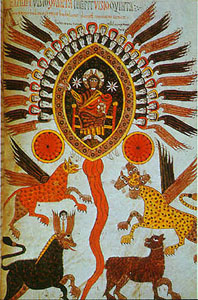 |
|
|
|
|
Class
Prep
|
|
|
|
- Israel:
Covenant in Apocalypse
-
 In our last class, we reached the Babylonian Exile (587-539
BCE) and the restoration of the Jewish leadership to Israel
in the late sixth century. For the next three centuries,
one empire or an other took turns with Israel, and tensions mounted over
pagan rule. The Persians (539-332 BCE) were succeeded
by the Hellenistic Empires after Alexander's conquest (the
Alexandrian-based Ptolemies and the Antioch-based Seleucids
duked it out over Israel from 332-ca.164 BCE), and
eventually the Romans took over (64 BCE). That
brief interlude of 100 years between the Seleucids and the
Romans was nominally one of Jewish independence, but the
kings of this time were so enamored of Greek culture that
they alienated conservative Jews more profoundly than even
the pagan rulers had.
In our last class, we reached the Babylonian Exile (587-539
BCE) and the restoration of the Jewish leadership to Israel
in the late sixth century. For the next three centuries,
one empire or an other took turns with Israel, and tensions mounted over
pagan rule. The Persians (539-332 BCE) were succeeded
by the Hellenistic Empires after Alexander's conquest (the
Alexandrian-based Ptolemies and the Antioch-based Seleucids
duked it out over Israel from 332-ca.164 BCE), and
eventually the Romans took over (64 BCE). That
brief interlude of 100 years between the Seleucids and the
Romans was nominally one of Jewish independence, but the
kings of this time were so enamored of Greek culture that
they alienated conservative Jews more profoundly than even
the pagan rulers had.
-
- It was in this period of cultural crisis around the year
200 BCE that apocalyptic literature was born.
"Apocalypse" means "revelation," but
ironically apocalyptic literature is the most obscure genre
in the Bible. The Book of Daniel in the Jewish
Scriptures and the Book of Revelation in the Christian New
Testament are the most famous examples of apocalyptic, but
there are also small apocalyptic sections in many other
New Testament gospels and letters, as well as many apocalyptic
texts that did not make it into either Jewish or Christian
Bibles.
-
- The Book of Daniel looks like it is written during the
Babylonian Exile (587-539 BCE), but don't be fooled by the
pretense of the story. The difference between
the story and discourse levels is nowhere more important
than in this genre, which seeks to hide (not reveal!) its
message so that the only ones who understand it are the
few "who have ears to hear" (and often even they
don't get it). The author uses the fiction of
a past crisis to explain the meaning and prophesy the resolution
of the present crisis. This technique is referred
to as "the apocalyptic method."
-
- As you read the three selected chapters from the Book
of Daniel, take notes not only on what is revealed, but
on how it is revealed. Consider the following
issues and questions:
-
-
- How is the revelation first communicated?
- How does it remain concealed?
- What steps must be taken to understand it?
- Who can understand it?
- What threatens the characters?
- Where is God?
-
- It might help you to refer to the Timeline
of Tanak and Deuterocanonical Books (pdf
24KB) that you printed for our last class to
help track where we are in the discourse history of the
Jewish Bible. We will also continue to practice linking the historical circumstances of the author (the discourse level) to the opinion of divine justice he promotes in his story (refer to the online
exercise for further practice).
-
-
- Assigned Readings
- Primary: Genesis 2:4b-3:24; Exodus 19-20; Deuteronomy
5-6; 2 Kings 22 ; then Genesis 1:1—2:4a;
Daniel 2; 5; 7
- Secondary: Online class prep
-
-
- Further Reading
 Collins,
John J. The Apocalyptic Imagination: An Introduction
to Jewish Apocalyptic Literature, 2d ed. Grand
Rapids, Michigan: William B. Eerdmans, 1998. Collins,
John J. The Apocalyptic Imagination: An Introduction
to Jewish Apocalyptic Literature, 2d ed. Grand
Rapids, Michigan: William B. Eerdmans, 1998.
-
 Collins,
John J., Bernard McGinn and Stephen J. Stein, eds. The
Encyclopedia of Apocalypticism, 3 vols. New
York: Continuum, 1998. Collins,
John J., Bernard McGinn and Stephen J. Stein, eds. The
Encyclopedia of Apocalypticism, 3 vols. New
York: Continuum, 1998.
-
- Collins,
John J. and Peter W. Flint, eds. The Book
of Daniel: Composition and Reception, 2 vols., VTSup
83.1-2, Formation and Interpretation of Old Testament Literature
2.1-2. Leiden: Brill, 2001.
-
- See also the complete bibliography on apocalyptic literature
and groups for the course, SCTR
132 Apocalypse Now, taught by C. Murphy at Santa Clara
University.
-
-
- Links
-
-
- Sources
- Photograph:
- Daniel:"Daniel's Vision of the 4 Beasts
and One Like the Son of Man, 12th Century Edition of
Commentary on Apocalypse by Beatus of Liebana,"
British Library ADD 11695, Folio 240, reproduced in
Bruce Chilton, "The Son of Man: Who Was He?"
Bible Review 12 (August 1996) 37.
|
|
|
|
|
